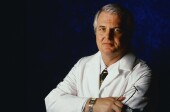
TUESDAY, Aug. 21 (HealthDay News) — The practice of referring a cancer patient to a radiation clinic with links to the referring doctor can be difficult for patients, a new study finds.
The study focused on urologists in Texas. It found that the practice caused some men with prostate cancer to travel more than three times farther to receive the treatment they needed.
The researchers said the findings call into question this practice, known as physician self-referral, and highlight concerns about the increase in urology-owned radiation oncology practices.
“Travel time to cancer care centers is crucial, especially for older men with advanced disease, because external radiation therapy often requires daily treatment for six to eight weeks,” Dr. Colleen Lawton, president-elect of the American Society for Radiation Oncology, said in a news release from the organization. “These patients often need to lean on friends and relatives to help them get to and from these multiple appointments.”
Lawton, who is also professor and vice-chairman of the department of radiation oncology at the Froedtert and Medical College Clinical Cancer Center in Milwaukee, said that doctors “must be judicious when proposing treatment options to our patients and appreciate the time and travel investment, including significant transportation and fuel costs, they make when choosing radiation therapy.”
In the study, researchers led by Dr. Benjamin Smith, of the University of Texas M.D. Anderson Cancer Center in Houston, looked at 229 urology practices in Texas. They found that 5 percent of the centers provided radiation oncology services (12 centers). The study also showed that 53 percent of the state’s population lives within 10 miles of these 12 centers.
However, although these urology-owned practices had multiple clinics, each practice had only one radiation oncology treatment center focused on prostate cancer treatment. As a result, men often could not receive the radiation therapy they needed at the same clinic where they were diagnosed.
Instead, they had to travel more than 26 minutes (a mean distance of 19.7 miles) to the nearest radiation oncology center. This added about 17 minutes to their traveling time.
The researchers pointed out that 28 percent of urologists in Texas currently work in practices that self-refer for radiation oncology services. This model of self-referral is under investigation by the U.S. Government Accountability Office over concerns that financial incentives could be causing patients to receive more costly, unnecessary or possibly less effective procedures.
The study authors noted their findings are limited because the study only included practices located in Texas. They suggested that more research is needed on how urology-owned self-referral practices also affect patient care, quality of treatment, patient satisfaction and treatment outcomes.
The study is published in the Sept. 1 issue of the International Journal of Radiation Oncology, Biology, Physics.
More information
The U.S. Centers for Medicare and Medicaid Services has more about physician self-referral.

